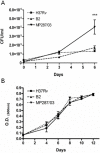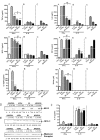Pathogenic Mycobacterium bovis strains differ in their ability to modulate the proinflammatory activation phenotype of macrophages
- PMID: 22863292
- PMCID: PMC3478980
- DOI: 10.1186/1471-2180-12-166
Pathogenic Mycobacterium bovis strains differ in their ability to modulate the proinflammatory activation phenotype of macrophages
Abstract
Background: Tuberculosis, caused by Mycobacterium tuberculosis or Mycobacterium bovis, remains one of the leading infectious diseases worldwide. The ability of mycobacteria to rapidly grow in host macrophages is a factor contributing to enhanced virulence of the bacteria and disease progression. Bactericidal functions of phagocytes are strictly dependent on activation status of these cells, regulated by the infecting agent and cytokines. Pathogenic mycobacteria can survive the hostile environment of the phagosome through interference with activation of bactericidal responses. To study the mechanisms employed by highly virulent mycobacteria to promote their intracellular survival, we investigated modulating effects of two pathogenic M. bovis isolates and a reference M. tuberculosis H37Rv strain, differing in their ability to multiply in macrophages, on activation phenotypes of the cells primed with major cytokines regulating proinflammatory macrophage activity.
Results: Bone marrow- derived macrophages obtained from C57BL/6 mice were infected by mycobacteria after a period of cell incubation with or without treatment with IFN-γ, inducing proinflammatory type-1 macrophages (M1), or IL-10, inducing anti-inflammatory type-2 cells (M2). Phenotypic profiling of M1 and M2 was then evaluated. The M. bovis strain MP287/03 was able to grow more efficiently in the untreated macrophages, compared with the strains B2 or H37Rv. This strain induced weaker secretion of proinflammatory cytokines, coinciding with higher expression of M2 cell markers, mannose receptor (MR) and arginase-1 (Arg-1). Treatment of macrophages with IFN-γ and infection by the strains B2 and H37Rv synergistically induced M1 polarization, leading to high levels of inducible nitric oxide synthase (iNOS) expression, and reduced expression of the Arg-1. In contrast, the cells infected with the strain MP287/03 expressed high levels of Arg-1 which competed with iNOS for the common substrate arginine, leading to lower levels of NO production.
Conclusions: The data obtained demonstrated that the strain, characterized by increased growth in macrophages, down- modulated classical macrophage activation, through induction of an atypical mixed M1/M2 phenotype.
Figures




References
Publication types
MeSH terms
Substances
LinkOut - more resources
Full Text Sources
Research Materials
Miscellaneous

